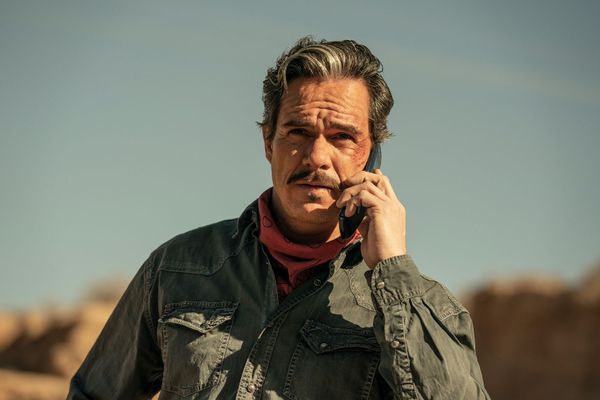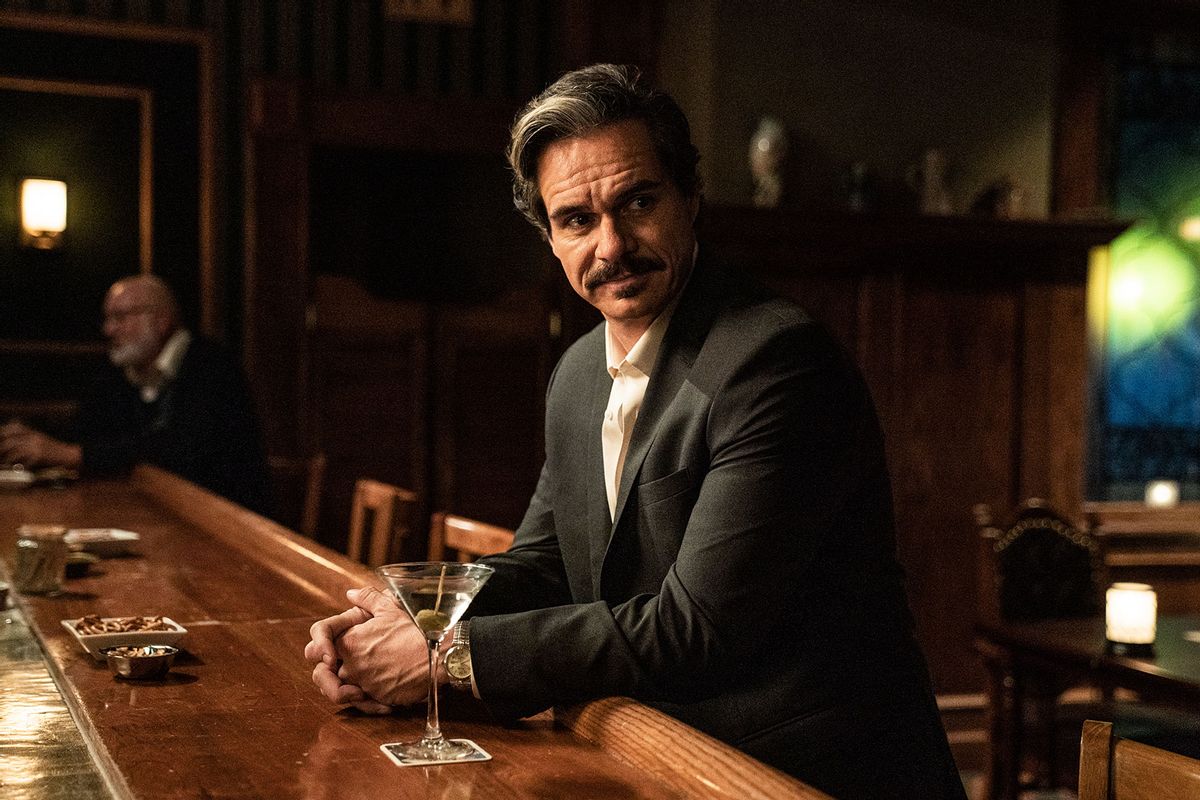Eduardo "Lalo" Salamanca styles himself as a gentleman with a soft smile that betrays little. The "Better Call Saul" villain, played by Tony Dalton, doesn't raise his voice, and when he does speak, he infuses his words with melodic cheer. The first time we meet him, which happens late in the fourth season, he's cooking while singing with the radio. When one of the Salamanca cartel's top men in Albuquerque walks in to confer with him, Lalo offers him a plate.
"Never in your life have you tasted something so delicious, it's true. Wait . . ." Lalo effuses in Spanish, dancing around the stove like a happy gourmand as he plates his creation.
Then he presents it to his man with what could be either an invitation or a threat: "You're gonna die."
He's talking about the flavor but, this being "Better Call Saul," he's also making a promise. The man he's chatting up is Nacho (Michael Mando) which, intentionally or not, makes this exchange a bit premonitory. This marks their first meeting, and it's quickly followed by a visit to the infirm Don Hector, Lalo's uncle, whose spirits Lalo lifts by reminiscing with him about a time dear tío tortured a hotelier to death.
RELATED: "Better Call Saul" cost of breaking good
Then Hector's nephew presents him with a souvenir from that crime that forever solidifies Lalo in the lore of both "Saul" and the "Breaking Bad" universe: the front desk's bell.
We haven't seen much of Lalo in the first half of this final season of "Better Call Saul," but now that he's resurfaced, the show's writers and Dalton remind us of this character's essential role in the story's examination of corruption. They cement in the viewer the truth that Lalo's charm and diplomacy are the traits that make him singularly terrifying and dangerous. He's a man who can take down two armed human traffickers without much fuss, but he'll also politely return the cash the men took from the people they were going to smuggle with a gentle offer of "be careful" before he walks off.
Lalo's charm and diplomacy are the traits that make him singularly terrifying and dangerous.
Lalo seems like the most reasonable of the Salamancas. Nothing like Tuco, the rage-aholic who frightened Walter White and breaks someone's legs if they look at him wrong. Not like The Cousins, Leonel and Marco, the heartless assassins who make offerings to some dark deity before they silently hunt their quarry. Dalton makes Lalo civil and sociable, the kind of man you would be fine inviting into your home under the right circumstances. That's the scariest part about him.
But the fifth and sixth episodes of the finale season demonstrate another aspect of Lalo's anxiety-provoking horror we may not have considered before, which is that he's a Mexican man who looks more European than indigenous. He's white, in other words, and that gives his brand of sinister global access that his nemesis Gus Fring (Giancarlo Esposito) doesn't enjoy as easily.
Dalton's performance doesn't specifically lean into that in his portrayal. Instead, the writers drop a few hints into the script in scenes where the Salamancas disparage Gus, especially when the latter over-delivers and shows up the criminal organization's legacy crew. Along with that, the actor capitalizes on the added weight with which his suave conviviality endows his character.
Gus and Lalo are two sides of the same coin. Both men have built an underground network to serve their needs: Gus' front involves thousands of chickens on a farm outside of town that appears to supply his chicken restaurants, Los Pollos Hermanos.
Lalo's involves a network of loyal regular folks South of the border supported by the Salamancas, as we see at the end of the fifth season and the opening of this sixth. After surviving an assassination, Lalo stumbles through the desert to find one of the families he's provided for.
 Tony Dalton as Lalo Salamanca in "Better Call Saul" (Greg Lewis/AMC/Sony Pictures Television)Unluckily for them, the man also happens to look a look like Lalo . . . meaning they too have always been livestock. Gus fries poultry; Lalo burns humans. The world needs to think he's dead. These two satisfy that aim by standing in for the bodies.
Tony Dalton as Lalo Salamanca in "Better Call Saul" (Greg Lewis/AMC/Sony Pictures Television)Unluckily for them, the man also happens to look a look like Lalo . . . meaning they too have always been livestock. Gus fries poultry; Lalo burns humans. The world needs to think he's dead. These two satisfy that aim by standing in for the bodies.
Gus is miles more elegant and well-mannered than Lalo is because he must be. His refinement and local philanthropy mask his criminal enterprises. He also has to behave impeccably in the community and to his cartel boss to survive. Whereas Lalo can simply be as he is and fit in with a few small adjustments, which is how Dalton delicately shades his psychopath.
RELATED: "Hawkeye" reminds us why Jeremy Renner's archer is the least Avenger
When Lalo pops up for the first time since the series premiere in the fifth episode, "Black and Blue," he's in a bar in Germany, wearing the suit of a handsome American who eases his way into the company of a woman named Margarethe. Lalo is soft-spoken and kind, and she views it as a coincidence that he's from the same town where her husband died.
But there's no such thing as chance in Lalo's world – she knows her husband, Werner Ziegler, was hired in secret by Gus, but never had proof of the reason or why.
This Lalo is charming, empathetic, and a bit melancholy. He wins her confidence with his wit and intellect and makes us fearfully hold our breath when it seems she might invite him into her home for a nightcap, or something more.
Because we know he's capable of a bloody sight more. We've seen the evidence. That's why he further frays our nerves when he breaks into her house the next day while she's at work and almost gets caught there when she doubles back. It's a relief that he doesn't ruin the fantasy he created the night before, choosing to exit by a window instead of lay in wait to kill her, as he easily could have.
The tension between Lalo and Gus has always been a matter of competing intellects.
Lalo is more than a survivor, you see. He's also a butcher. In Margarethe's home, he finds a means of tracking down the men who worked with Werner on Gus' mystery construction. In the sixth episode, "Axe and Grind," he finds one named Casper (Stefan Kapičić), one of Werner's former employees, calmly walking onto his property with the same friendly smile before pursuing him through the woods.
"Axe and Grind" is the first episode that Esposito directs, giving the man who plays Gus Fring a shot at contributing to the legacy of his character's nemesis. This layers an extra measure of precision to what we see, especially at the point where it looks like Lalo may meet his end by way of an ax chop.
Want a daily wrap-up of all the news and commentary Salon has to offer? Subscribe to our morning newsletter, Crash Course.
Casper and Lalo end up in a dimly lit shed where Lalo lets Casper think he has him on the ropes, wheezing Margarethe's name just to get him close enough to stab Casper and then chop through his leg – all a precursor to what is certain to be an information-gathering torture fest. Even then there's no yelling; Lalo simply pulls off his belt and hands it to Casper. "Tie that off before you bleed to death," he says. "You and I are going to have a talk."
From the moment Lalo enters the picture, he is obsessed with taking down Gus.
The Salamancas and Gus are the two sides of the cartel's New Mexico operation, with the former providing the muscle and the latter facilitating the operational side of their drug running.
But the tension between Lalo and Gus has always been a matter of competing intellects. Lalo always (correctly) suspected that Gus was sabotaging the Salamancas' side of the operation and building something outside of the cartel's reach; Gus (correctly) suspected that Lalo was on to him, which is why he tried to have him killed.
That mission's failure means the threat of Lalo has haunted these last few episodes, always felt but not seen, and the Germany trip reminds us of why Gus and his men, along with Kim (Rhea Seehorn) and Jimmy (Bob Odenkirk) are so nervous about his survival. His encounter with Margarethe substantiates that he can slide into any place and any conversation and gain people's trust without being questioned.
"Axe and Grind," the penultimate episode before "Better Call Saul" takes its midseason break, is noteworthy for its glimpse at a formative episode in Kim Wexler's life, where we learn why she's drawn to Jimmy and his grifting ways.
This explains why she's so willing to toss aside an opportunity that would enable her to do legitimately philanthropic work in her field to assist Jimmy to pull off the season-long con he's been teeing up to take down his former boss and tormentor Howard Hamlin (Patrick Fabian).
But Lalo's exploits in Germany explain why Lalo is one of the most fascinating characters in this universe, joining Nacho as the other "Better Call Saul" character who was mentioned but never seen in "Breaking Bad."
To Walter White, he was a name. To us, and through Dalton, he is the type of demon we can't look away from – one who wears the enticing skin of a seducer and lures us to a place of intimacy before slicing apart our sense of safety.
New episodes of "Better Call Saul" air at 9 p.m. Mondays on AMC.
More stories like this:
- "Better Call Saul" is in no hurry to end
- Giancarlo Esposito is everywhere
- Better Call Saul asks: Cash or justice?
- Bob Odenkirk on a "brutal" season

Shares